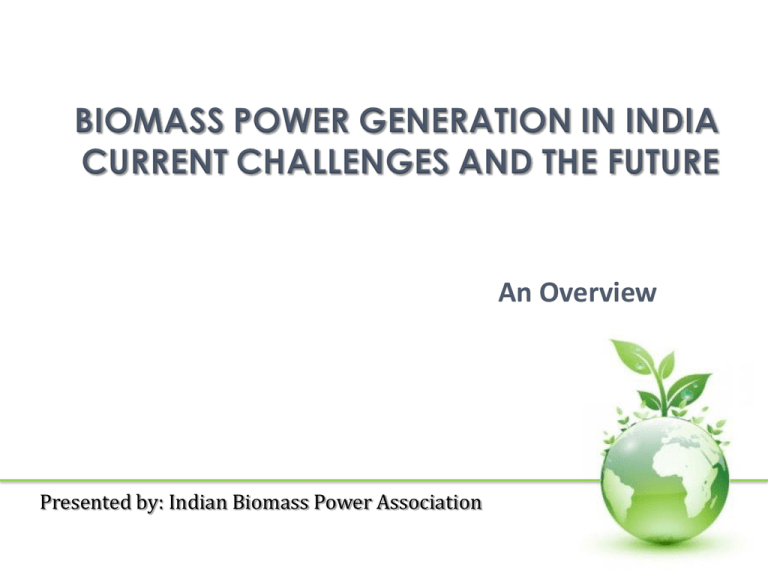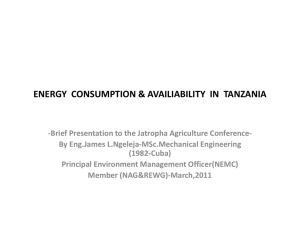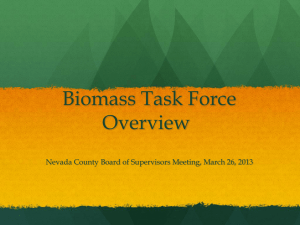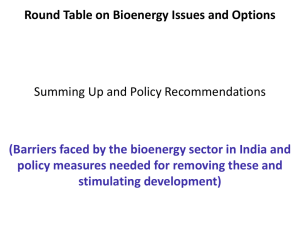Biomass Power Generation in India
advertisement

An Overview Presented by: Indian Biomass Power Association Indian Power Scenario Date 31.03.1990 31.03.1992 31.03.2002 31.03.2007 31.03.2008 31.03.2009 31.03.2010 31.03.2011 31.03.2012 31.03.2017 ** Renewable Total Power Power Generation Generation 63636 18 69065 32 105046 1658 132329 7761 143061 11125 147965 13242 159398 15521 173626 18455 199877 24503 318414 54503 ** Projection % 0.03% 0.05% 1.58% 5.86% 7.78% 8.95% 9.74% 10.63% 12.26% 17.12% Indian Power Sector Today Predominantly dependent on depleting fossil fuel and driven by imports of Coal Raising prices internationally affects balance of Trade in India State utilities under going difficult times financially affecting down stream generators Renewable Energy Sector affected by higher cost of funding and infrastructure costs Capacity additions behind plans --resulting in demand – supply gap Need For Renewable Energy Carbon dioxide emissions (CO2), thousand metric tons of CO2 in India 1990 1995 2000 2005 2006 2007 2008 690577 920047 1186663 1411128 1504365 1612384 1742698 Source : Global Climate Change Initiative To mitigate the above increase in the CO2 Emissions , there is an urgent need to increase the renewable power Potential comparison Biomass and Wind as on 30-09-2012 Particulars POTENTIAL (MW) INSTALLED CAPACITY (MW) Biomass 18000 1210 WIND 102000 17967 Biomass as RE Power– The Advantages Plants are mostly be located even in the remote rural areas- close to agri waste source All investments are done in backward rural areas and meets the power requirement of rural area The only FIRM Power amongst all Renewable source of energy that can generate over 80% PLF. Current potential of 18000 MW in India – Commissioned only 1210 Mw till 30th Sep.’12 Apart from the up liftment of rural economy, it also saves transmission and distribution losses 70% of biomass tariff goes into the rural communities who are the suppliers of Fuel . Only Renewable energy that supports Agriculture by: Direct Local employment 50000 people Indirect employment – 400000 people Generates additional income to the farmers by the sale of Agri waste and waste wood to the Biomass industry to use as fuel. Can put to use Arid land for Energy Plantations which will provide additional income to Farmers All Plant and Machineries are indigenous - hence unlike other RE technologies the entire investment supports domestic industries Sector – Current Status & difficulties Current Status The sector is on the brink of closure simply because of inadequate support from the policy makers and regulatory commissions 70% of the biomass tariff spent for fuel only , which is purchased from the rural systems & Farmers. The feed stock- biomass cost increased significantly in the past 3 years due to inflation and significant raise in other fuel costs Biomass sector apart from generating green power, meets the hopes and aspiration of rural population and rural India. Out of 1210 Mw, 70% have closed and balance running in losses. Difficulties Biomass is the only RE sector, for which the fuel is not natural or free for operation though it is said to be abundantly available The cost of fuel is not correlated properly with the tariff . Unrealistic tariff makes the projects unviable and need for annual reset based on biomass fuel cost can mitigate the same In the absence of definite national policy , the sector is desperately seeking for lifeline and solution to its problem for survival Why the Low Growth , despite the advantages ? Higher cost of Finance to the Industry almost at almost 15-17% interest Inadequate Government Support on Policies Increasing Fuel, Capital & O&M Costs Lack of attractive Capital Subsidy Challenges in sourcing of raw material in spite of current availability of biomass, say about 500 million tons equivalent to 18000 MW – after adjusting for other usage/collectability. Unviable Tariff set by the SERC /CERC – not in line with actual costs Absence of National Level Policy Expectation from Government • Being the Apex body for the development of Renewable energy in our country . • The investment done in the biomass sector is at highest risk and the sector has been forced to a brink of closure, it requires support and help from the government for operation and revival. • The association request MNRE to take up the matter with Finance & Power Ministry for approving suitable provisions enabling the sector to a survival & revival path. • The association also request MNRE to initiate and approve within its policy promotion measures for biomass sector enabling the sector to survive and revive. • The rate of Interest for biomass sector to be limited to 10% or at Priority Sector levels as current interest rates of 15-17% is making it extremely difficult for any additional investment . • Majority of the biomass investment has either become NPA or operating in huge losses. A financial restructuring on lending with interest subvention may be provided for the next 5 years enabling the sector to climb back. The interest subvention may be linked to prompt and regular payment of interest. • Enhancement of Central Financial Assistance (Capital Subsidy ) - Not revised for years . To make it on par with Biogasification at Rs.80 lacs/Mw, not exceeding Rs.500 lacs • Biomass Mission - to be implemented across the Country with definite and exclusive fuel availability to this sector by prioritizing . • Fuel Adjustment Mechanism (FAM) should be formulated yearly and request MNRE to extend support to CERC in tariff fixation annually. • Allocation of unused/waste land for Captive Energy Plantations for Fuel Sustainability . Can model it on Rajasthan Policy of 500 Hectares per MW across States Coordination with Power Ministry • MNRE must urgently coordinate with Power Ministry to find the solution of SERC via forum of regulators to look into the issues faced by the biomass sector as RE power. • Though the electricity act has various provisions laid down to support RE power, SERC’s are not keen on implementing those due to their own state related issues. MNRE should monitor and enforce and address such issues . • The Power Ministry and MNRE should work out urgent solutions for the survival of the biomass sector by framing a support policy – waiver of Cross Subsidy, Electricity Tax, adjustment of power import against export and the like Request to MNRE by Indian Biomass Power Association • The ministry must initiate suitable measures for the revival of investment already done in the biomass sector. • The association request clear steps for the revival of the biomass sector and an opportunity to redeem the losses forced due to past difficulties by giving them opportunity to recover the past losses in future generation by approving suitable generation based incentive. • A suitable GBI may be explored through the clean energy fund for this sector survival. • Indexing of biomass REC at 2 times and recommending the same to CERC considering the cost of fuel and its operation in the rural sector. Alternatively as separate Floor and Forbearance prices can be set as in case of Solar RECs Biomass Mission The launch of Biomass Mission similar to Solar Mission by the Ministry, which would specifically look into: a) Guiding the States to Formulate separate Biomass policy b) Framing a Suitable policy to promote energy plantation development for captive use. c) Enhancing the Current subsidy levels for sustained operation of the Biomass Power Generation. d) Revival and operation of existing investment in biomass sector. e) Development and promotion of biomass sector f) A suitable option for meeting the electricity requirement and hopes and aspiration of rural India. To Sum up Key Issues needing urgent support are….. • Interest subvention on par with Agri/Priority Sector--- since all Biomass Plants are in rural India supporting the farmers by sourcing the agri residues • Annual tariff adjustment for Fuel Cost increase • Separate REC Slab for Biomass RECs like Solar – considering the fact that this is the only Renewable Energy depending on sourced fuel. Alternatively indexing with Non-Solar RECs as 2 RECs for 1 MwH of Biomass Power • Effective implementation of RPO/REC Mechanism to ensure compliance levels envisaged are met. Perhaps use of National Clean Energy Fund by MNRE for RPO Compliance by State Utilities thru suitable support for a year or two • • Review of Tariff structure considering inputs given by Industry Support to develop Energy Plantations & Biomass Mission by MNRE







